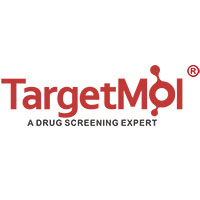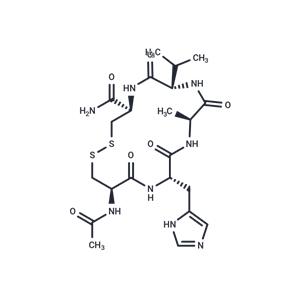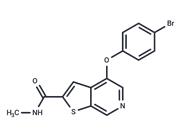| Name | ADH-1 |
| Description | ADH-1 (Exherin) is an N-cadherin antagonist, inhibits N-cadherin mediated cell adhesion with potential antineoplastic and antiangiogenic activities. |
| Kinase Assay | Kinase Activity Assays: The effect of VX-509 on JAK3 activity is assessed by measuring the residual kinase activity of the recombinantly expressed JAK3 kinase domain using a radiometric assay. The final concentrations of the components in the assay are as follows: 100 mM HEPES (pH 7.5), 10 mM MgCl2, 1 mM dithiothreitol (DTT), 0.01% BSA, 0.25 nM JAK3, 0.25 mg/ml polyE4Y, and 5 μM 33P-γ-ATP (200 μCi/μMol). A 10 mM stock solution of VX-509 is prepared in DMSO, from which additional dilutions are prepared. A substrate mixture (100 mM HEPES, 10 mM MgCl2, 0.5 mg/ml polyE4Y, and 10 μM 33P-γ-ATP) is added and mixed with VX-509 stock solution. The reaction is initiated by the addition of an enzyme mixture [100 mM HEPES (pH 7.5), 10 mM MgCl2, 2 mM DTT, 0.02% BSA, 0.5 nM JAK3]. After 15 minutes, the reaction was quenched with 20% trichloroacetic acid (TCA). The quenched reaction was transferred to the GF/B filter plates and washed three times with 5% TCA. Following the addition of Ultimate Gold scintillant (50 μl), the samples were counted in a Packard TopCount gamma counter (PerkinElmer). In this procedure, the radioactivity trapped is a measure of the residual JAK3 kinase activity. From the activity versus concentration of VX-509 titration curve, the Ki value was determined by fitting the data to an equation for competitive tight binding inhibition kinetics using Prism software. |
| In vitro | ADH-1 (0.2 mg/mL) blocks collagen I-mediated changes in pancreatic cancer cells, and is highly effective at preventing cell motility that is induced by expression of N-cadherin. ADH-1 (0, 0.1, 0.2, 0.5 and 1.0 mg/mL) induces apoptosis in a dose-dependent and N-cadherin-dependent manner[1]. |
| In vivo | ADH-1 (50 mg/kg) significantly prevents tumor growth and metastasis in a mouse model for pancreatic cancer. ADH-1 prevents tumor cell invasion and metastasis in an orthotopic model for pancreatic cancer using N-cadherin overexpressing BxPC-3 cells[1]. ADH-1, at the dosages evaluated, does not display either antiangiogenic activity in a rat aortic ring assay or antitumor potential in a PC3 subcutaneous xenograft tumor model[2]. ADH-1 (10 mL/kg, i.p.) augmentation of melanoma tumor growth is overcome through its ability to make regionally infused melphalan more effective. ADH-1 mediated augmentation of melanoma tumor growth is not altered by regionally infused temozolomide. In A375, but not DM443 xenografts, ADH-1 treatment increases phosphorylation of AKT at serine 473. ADH-1 slightly diminishes N-cadherin expression in both xenografts[3]. |
| Storage | keep away from moisture,keep away from direct sunlight,store at low temperature | Powder: -20°C for 3 years | In solvent: -80°C for 1 year | Shipping with blue ice/Shipping at ambient temperature. |
| Solubility Information | DMSO : 10 mM, Sonication is recommended.
10% DMSO+40% PEG300+5% Tween 80+45% Saline : 2 mg/mL (3.5 mM), Sonication is recommended.
|
| Keywords | N-cadherin | Inhibitor | inhibit | ADH-1 | ADH1 | ADH 1 |
| Inhibitors Related | Lycorine hydrochloride |

 United States
United States






